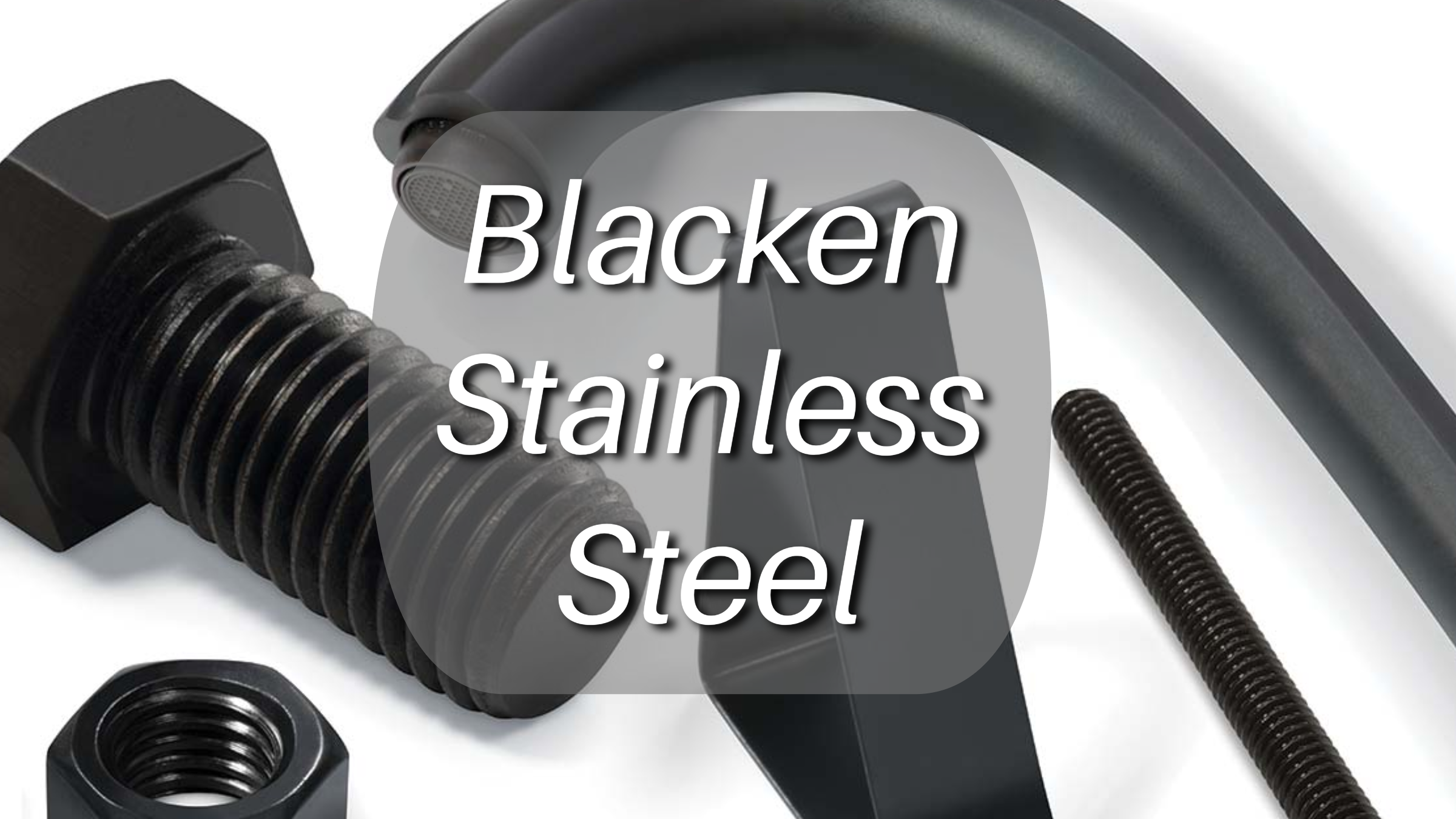Blacken Stainless Steel: Achieve Perfect Results [+Expert Tips & Techniques]

Discover everything you need to know about blackening stainless steel. This guide provides a method comparison chart, plus essential tips to help you optimize your workflow.
Introduction
Black oxide stainless steel isn't actually a different kind of stainless steel, but rather a type of finish that can be applied to stainless steel components. This conversion coating creates a thin layer of black oxide on the surface of the stainless steel, resulting in a number of functional and aesthetic benefits.
For more information, please refer to Unionfab’s post-processing services.
What is Black Oxide Stainless Steel
Black oxide stainless steel isn't a new type of steel, but rather stainless steel with a specifically treated surface. This treatment creates a thin layer of black oxide, typically magnetite (Fe₃O₄), that alters the appearance and some properties of the underlying steel.
Overview of the Blackening Process
Blackening disrupts the natural chromium oxide layer on stainless steel and replaces it with a controlled black oxide film. This film offers some unique properties compared to the natural layer.
The specific process varies depending on the chosen method (chemical, electrochemical, or thermal) but generally involves surface preparation,blackening treatment, neutralization and rinsing and finishing (optional).
Blackening Methods [+Comparison]
Chemical Methods: This is the most popular method due to its simplicity and affordability. It involves submerging the stainless steel in a hot alkaline salt solution for a controlled period.
Electrochemical Methods: This method utilizes an electric current to control the formation of the black oxide layer.The stainless steel acts as the anode (positive electrode) in an electrolyte bath, and the electric current drives the oxidation process.
Thermal Methods: This method involves exposing the stainless steel to high temperatures in a controlled atmosphere.
Method | Durability | Finish Quality | Cost Efficiency | Pros | Cons | Best For |
|---|---|---|---|---|---|---|
Chemical Blackening | ★★★★☆ | ★★★★☆ | ★★★★☆ | - Provides corrosion resistance | - Limited to certain alloys | Industrial applications, tools, machinery |
Physical Vapor Deposition (PVD) | ★★★★★ | ★★★★★ | ★★★☆☆ | - Extremely durable | - High initial cost | High-end consumer products, automotive trim |
Anodizing | ★★★☆☆ | ★★★☆☆ | ★★★★☆ | - Lightweight finish | - Limited application for true stainless | Decorative items, lightweight components |
Paint or Powder Coating | ★★★☆☆ | ★★★★☆ | ★★★★☆ | - Versatile and widely available | - Less durable compared to other methods | Aesthetic enhancements, quick customizations |
Key Takeaways
Chemical Blackening: Best for industries needing functional coatings at scale.
PVD: Perfect for luxury or high-performance applications due to its superior finish and longevity.
Anodizing: Ideal for specific lightweight components, though limited to aluminum stainless alloys.
Paint or Powder Coating: A cost-efficient option for custom aesthetics, but not as durable for heavy-use parts.
Looking to achieve perfectly blackened stainless steel parts? Unionfab's expert post-processing services ensure durability, aesthetics, and precision.
While blackening isn’t available in our instant quoting system, you can easily contact us for custom finishing solutions. Let us handle the intricate work while you focus on your designs!

Benefits of Black Oxide Stainless Steel
Black oxide stainless steel offers several advantages over regular stainless steel, making it a desirable choice for various applications.
Enhanced Corrosion Resistance: The black oxide layer can provide an additional layer of protection, especially when sealed.
Improved Aesthetic Appeal: The black color can enhance the appearance of a product, making it look more modern, high-tech, or even luxurious depending on the application.
Increased Wear Resistance: The black oxide layer adds a touch of extra resilience against scratches and wear, making it ideal for parts that experience friction.
Reduced Light Reflection: Black oxide stainless steel has a significantly lower light reflectivity .This is good for optical instruments, camera equipment, or reducing glare in architectural components.
Blackening Process: A Step-by-Step Breakdown
Pre-treatment Preparation
Cleaning
The stainless steel surface must be thoroughly cleaned to remove any dirt, grease, oils, or contaminants.
Degreasing
Any remaining residues can hinder the blackening process and lead to an uneven finish.
Abrasion (Optional)
For a better mechanical bond between the black oxide layer and the stainless steel, the surface may be lightly abraded using a fine grit sandpaper or blasting media.
Activation (Optional)
In some cases, the stainless steel surface may be treated with a mild acidic solution to activate the metal surface for a more receptive blackening process.
Application Methods
Chemical Blackening
Process: This involves immersing the metal in a hot chemical solution, typically containing alkaline salts and oxidizers. The solution reacts with the metal surface to form a thin layer of black oxide, most commonly magnetite (Fe₃O₄).
Advantages: Simple and relatively inexpensive process. Good for batch processing of small parts. Provides some corrosion resistance.
Disadvantages: Requires high temperatures (often boiling). Can be time-consuming. May not be suitable for all metals. Chemical solutions can be hazardous and require proper disposal.
Electrochemical Blackening
Process: Similar to chemical blackening, but uses an electrical current to promote the formation of the oxide layer. The metal acts as the anode in an electrolytic bath containing the blackening solution.
Advantages: Lower temperatures are possible compared to chemical blackening. Offers more control over the thickness and uniformity of the black layer. Can be more environmentally friendly by avoiding hazardous chemicals.
Disadvantages: More complex setup compared to chemical blackening. Requires electrical equipment and knowledge. May not be suitable for all part geometries.
Thermal Blackening
Process: This method involves heating the metal in a controlled atmosphere to create an oxide layer. The specific atmosphere and temperature used determine the oxide formed and the resulting black color.
Advantages: Produces a very adherent and corrosion-resistant black finish. Can be used on a wider variety of metals.
Disadvantages: Requires specialized equipment and high temperatures. Can be a slow process. May cause distortion in some metals.
Post-treatment Finishing
Neutralization and Rinsing
The blackening process is stopped, and the component is thoroughly rinsed with water to remove any residual chemicals or contaminants that might affect the finish or future performance.
Drying
The part is carefully dried to prevent rust or staining.
Sealing (Optional)
A sealant or oil can be applied to the black oxide layer to enhance its corrosion resistance and improve the overall appearance.
Oiling (Optional)
Oiling can provide some additional protection against wear and tear and enhance the black color's depth and richness.
Tips for Achieving the Ideal Blackening Results
1. Understand Your Material
Different grades of stainless steel react differently to blackening processes. For instance:
High Chromium Content: May blacken more slowly and might require specialized blackening solutions or extended processing times.
Low-Alloy Stainless Steels: Generally easier to blacken due to simpler oxide layer formation.
Tip: Consult your material supplier or test a sample to determine the optimal blackening solution and method for your stainless steel grade.
⠀
2. Prepare the Surface
Thorough Cleaning Is Critical:
Remove all contaminants, oils, and greases using solvents or alkaline cleaners.
Sand or polish surfaces to remove scale, rust, or imperfections that might hinder the uniformity of the blackened layer.
Degreasing: Use a high-quality degreaser to eliminate residue.
Tip: A clean, smooth surface ensures better adhesion and a more consistent finish. Test the surface with a water-break test—if water beads, clean again.
⠀
3. Select the Best Blackening Method
Depending on your desired finish and application, choose the appropriate blackening method:
Chemical Blackening:
Use a high-quality blackening solution formulated for stainless steel.
Control Temperature: Follow the recommended temperature range, typically between 80–95°C, for optimal oxide formation.
Monitor Immersion Time: Over-immersion can lead to uneven finishes, while under-immersion might result in insufficient coverage.
Tip: Regularly maintain and test your chemical solution to ensure consistent performance.
Electrochemical Blackening:
Adjust Current Density: Higher current densities can speed up the process but may reduce uniformity. Lower settings often produce a more even oxide layer.
Control Time: Monitor the process closely to prevent over-blackening or uneven coloration.
Tip: Use precision equipment for consistent results and periodically calibrate your setup.
Thermal Blackening:
Temperature Control: Achieve the desired oxide layer thickness by maintaining a stable blackening temperature (usually around 400–600°C).
Protective Atmosphere: Use inert gases or controlled environments to reduce unwanted oxidation or discoloration.
Tip: Preheat materials evenly to avoid thermal stress or uneven finishes.
⠀
4. Don’t Overlook Post-Treatment Processes
Sealing:
Apply a high-quality sealant to fill microscopic pores in the black oxide layer, which boosts corrosion resistance and longevity.
Tip: Use a water-repellent or anti-corrosion sealant for applications exposed to harsh environments.
Oiling:
Enhance the black color’s depth and richness while adding a protective layer against wear and tear.
Tip: Use non-drying oils for easy reapplication and long-term protection.
Applications of Blackened Stainless Steel
Architectural and Decorative Elements
Blackened stainless steel's sleek and modern appearance makes it a popular choice for architectural cladding, facades, panels, and trim.
Automotive and Aerospace
Blackened stainless steel finds applications in automotive components due to its wear resistance and ability to withstand harsh environments. In the aerospace industry, blackened stainless steel might be used for specific non-critical components due to its lightweight properties and ability to handle temperature variations.
Firearms and Weaponry
Black oxide is a common treatment for firearm components due to its ability to improve wear resistance and reduce glare.
Consumer Products and Electronics
Blackened stainless steel is used in consumer electronics like laptops, smartphones, and other gadgets due to its premium look and resistance to fingerprints compared to traditional stainless steel finishes.
Conclusion
Blacken stainless steel offers improved scratch resistance, reduced glare, and a touch more protection from rust compared to regular stainless steel. This makes it a great choice for everything from fancy buildings to household appliances and even some firearm parts.
Why Choose Unionfab for Your Blackening Needs?
Your One-stop Shop: From stainless steel manufacturing to specialized finishes, we’re your one-stop shop for metal fabrication.
Expert Techniques: Our blackening services enhance both the functionality and appearance of your parts.
Custom Support: Every project is unique, and our experts work closely with you to ensure exceptional results.
Contact Unionfab today to discuss your specific needs and see how our finishing services can elevate your project.


